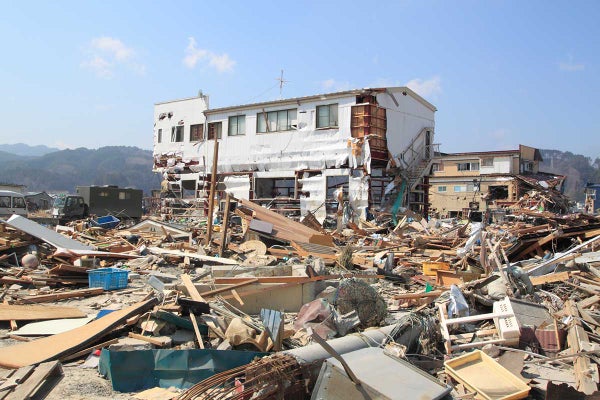In a first-of-its-kind finding, researchers note that large quakes off Japan’s northeastern coast are often presaged by subtle movements on submarine fault zones. Although these speedups in slippage along submarine faults, discernable by GPS equipment onshore, will not enable researchers to make a “We’re gonna have a magnitude 7.3 quake next Thursday at 3:37 P.M.” sort of prediction, they do provide insights into general patterns of seismic activity in the region and may ultimately give scientists a better understanding of what is happening along fault zones.
The researchers sorted through the listing of quakes that occurred before 2011 along the northeastern coast of Honshu and southeastern coast of Hokkaido, Japan’s two largest islands, where tectonic forces slowly shove the western edge of the North American Plate beneath the Eurasian Plate and create a seafloor feature called the Japan Trench, linked to earthquakes and tsunamis in the region. From that list, which along the central stretch of coast includes data for quakes as far back as 1984, the team identified more than 1,500 sequences in which quakes seemed to repeat themselves over time, occurring at the same place with more or less the same magnitude, says the study’s lead author Naoki Uchida, a geophysicist at Tohoku University in Japan. From the magnitude and frequency of those temblors, he and his colleagues were able to estimate the rates at which the tectonic plates were sliding past each other at each site. In some places the rates surged and stalled in three-year cycles, with speeds ranging from zero (when the faults were locked) to, at peak speed, nearly four times normal, the researchers report in this week’s Science.
Then, the team looked at how those varying rates of slippage might be statistically correlated with other, nonrepeating quakes in the region whose magnitudes were magnitude 5 or larger. They found that in many instances the rates of inferred slippage accelerated in the days leading up to nearby quakes, Uchida says. Thus, the team’s analysis suggests that gradual slippage along the tectonic interface shifts the seismic stress that is building up along the fault into nearby areas, where it eventually triggers a sudden slip—otherwise known as a quake.
On supporting science journalism
If you're enjoying this article, consider supporting our award-winning journalism by subscribing. By purchasing a subscription you are helping to ensure the future of impactful stories about the discoveries and ideas shaping our world today.
Analyses of data gathered by onshore GPS stations, which over the long term reveal the movements of the tectonic plate on which they’re mounted, show that their motions generally match the inferred rates of slippage along offshore faults. So, in a rough sense, the movements of the GPS equipment may presage impending quakes, Uchida says.
The team’s research “is quite solid and presents some exciting conclusions,” says Jeffrey Freymueller, a geophysicist at the University of Alaska, Fairbanks who was not part of the study. It stands to reason, he notes, that if the slippage along the tectonic interface offshore is periodic, then the seismic stress building up nearby where large quakes occur will be periodic as well. “Many people have speculated that this should be the case but this paper is the most convincing evidence yet,” Freymueller says.
The findings “are potentially a powerful tool” to probe what’s happening along the region’s submarine faults, says Paul Segall, a geophysicist at Stanford University, also not involved with the research. He admits, however, “this is kind of a provocative result, in the realm of things that are suggestive.” Whether the analysis offers anything that is relevant toward earthquake prediction is yet to be seen, he adds.
Although the statistical linkage discovered by Uchida and his colleagues suggests that an increase in tectonic slippage precedes nearby quakes, it is possible that another phenomenon entirely could be causing both, says Manoochehr Shirzaei, a geophysicist at Arizona State University in Tempe. For example, an increase in the fluid pressure within the rocks of the fault itself (a parameter known as pore pressure) could be decreasing friction within the fault and thus lubricating it, triggering both the accelerated slippage in one area and the quake nearby. He and his colleagues are now investigating that notion, and others, to see if they can discern what’s going on in the faults off Japan and whether that might relate to what happens at similar tectonic interfaces elsewhere in the world.
“The answers may help scientists better understand how a subduction zone behaves,” Shirzaei says. “No one really knows how the system works.”
